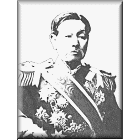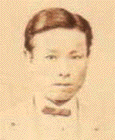 |
Shizuoka Profiles: Inoue Kaoru
|

|
 |
Shizuoka Profiles: Inoue Kaoru
|

|
Inoue Kaoru was a Japanese statesman who lived in Shizuoka City
during his final years. Born to a samurai family in 1835 in southwestern Japan, he studied Dutch and the military arts as a youth and was influenced by Yoshida Shouin's teachings. In 1850 he joined the Sonou Joui movement, seeking to restore the Emperor to the throne and expel foreigners. Like many of his time, Inoue feared Japan would be colonized by Western powers unless it became a strong military power.
In 1858 Inoue went to Edo (Tokyo) to further his studies. There he met many persons with kindred sentiments. In 1861 Inoue participated in the burning of the British Consulate. Though he spent seven days in jail as a consequence, he was soon promoted to palace guard and nicknamed "Monta" (lit. "ask too much").
At an early age Inoue came to understand that it was imperative for Japan to learn more about Western technology. He aspired to see Europe firsthand and secretly got aboard an English clipper ship in May 1862 with two friends, Itou Hirobumi and Yamao Yozo. Studying English intensively en route, Inoue spent six months1 in the United Kingdom. Hearing that European vessels were bombarding Shimonoseki, he hastily returned to Japan. In the 1860's, Inoue helped cement an alliance between the Satsuma and Chooshuu factions. This alliance soon gained enough momentum to topple the shogunate and Inoue battled pro-shogunate forces at Wakamatsu.
Inoue held many key positions in the Meiji government, such as asst. minister of finance, governor of Okinawa, minister of public works, acting prime minister, and eventually elder statesman. In 1888 he became Japan's first minister of foreign affairs. Trying to repeal the unequal treaties which Western powers had imposed on Japan two decades earlier, it took decades to achieve success.
Inoue's policies proved unpopular at times, but he was convinced he had Japan's best interests at heart. His fiery temperament and repartee contrasted sharply with the stoic
coolness of Saionji Kinmochi.
Inoue developed close ties with the Mitsui family during his career. Saigo Takamori derided him as the "Chief Minister for Mitsui". Convinced of the need for Japan to industrialize, Inoue believed that what was good for Mitsui would also benefit the whole nation.
Following China's defeat in the Sino-Japanese conflict in 1895, Japan vied with Russia for far-eastern supremacy. The territory south of the Amur River came under dispute. As war loomed closer, there was concern about the costs of a protracted conflict with Russia. There was also uncertainty about what to do with Korea, where pro-Russian sentiment
ran high. The Anglo-American powers encouraged Japan to "take care of Korea"2
and Inoue promised to secure funding for the Russo-Japanese conflict. Special taxes were raised and Anglo-American banks lent Japan seven million yen. Some 400,0003 deaths later, Inoue was awarded for his patriotic service and raised in rank to marquis.
In 1909 Inoue fell ill and for the next six years his health tottered.
Spending most of his time in semi-retirement at his villa in Okitsu, he visited Tokyo only occasionally.
In 1915 he and his wife passed away. Unfortunately, his villa, like so many buildings in Shizuoka,
was destroyed by B-29s during World War II. Today a statue of Inoue sits in quiet repose in
Kiyomigata Park, 1.5 km west of Okitsu Station. Inoue is remembered
as a bureacrat who staunchly supported big-business interests and helped transform 19th Century Japan from a feudal society into a
20th Century industrial power to be reckoned with.
1 Some references suggest Inoue spent three years in the U.K. At that time, it took 3-5 months to reach England by ship via Shanghai or Hong Kong.
2 Refer to the Katsura-Taft Agreement of 29 July 1905 and also the Anglo-Japanese Alliance that same year.
3 Figures of casualties vary. This data is from Osaka Shoten's "Chuugaku Shakai" (1992: 210), a textbook approved by the Japanese Ministry of Education.